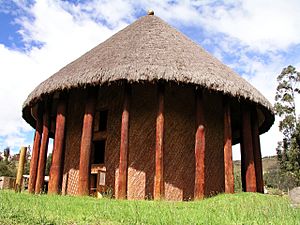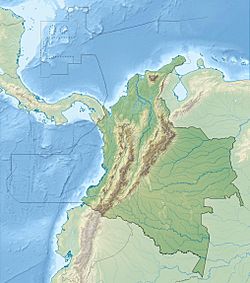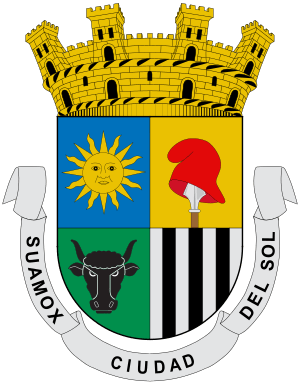Sun Temple (Sogamoso) facts for kids

This is how the Sun Temple might have looked.
Archaeology Museum, Sogamoso |
|
| Location | Sogamoso, Boyacá |
|---|---|
| Region | Altiplano Cundiboyacense, |
| Coordinates | 5°42′34.57″N 72°55′34.98″W / 5.7096028°N 72.9263833°W |
| Altitude | 2,503 m (8,212 ft) |
| Type | Temple |
| Part of | Archaeology Museum, Sogamoso Muisca sites |
| Height | 18 metres (59 ft) |
| History | |
| Material | Wood, clay, reed |
| Abandoned | Spanish conquest |
| Periods | Late Muisca |
| Cultures | Muisca |
| Satellite of | Sugamuxi |
| Associated with | Sugamuxi |
| Site notes | |
| Excavation dates | 1942 |
| Archaeologists | Eliécer Silva Celis |
| Condition | Destroyed, reconstructed |
| Public access | Yes |
The Sun Temple in Sogamoso was a special building. The Muisca built it to worship their Sun god, Sué. This temple was in Sogamoso, Colombia. Back then, this area was part of the Muisca Confederation. The Muisca called Sogamoso "Sugamuxi."
This temple was the most important place for the Muisca religion. But it was burned down by Spanish explorers. These explorers were led by Gonzalo Jiménez de Quesada. They were looking for the legendary city of gold, El Dorado. Today, a new version of the temple has been built. You can see it at the Archeology Museum in Sogamoso.
Contents
What the Sun Temple Looked Like
The Sun Temple was built next to the Monquirá River. It was a large, round building. Its walls were made of poles and clay. The roof was made of reed plants. The temple had no windows.
Inside, there were three circles of wooden columns. These columns came from trees in Casanare. The temple was built to represent the universe. It honored the Sun god Sué. Important Muisca leaders, called caciques, and priests were buried here.
Muisca Knowledge of the Stars
The Muisca people knew a lot about astronomy. They built many sites based on the stars. One such place, El Infiernito, still exists near Villa de Leyva. The Sun Temple was also built to line up with the Sun's positions.
Leaders like the caciques and zaques held ceremonies at the temple. A mythical figure named Idacansás led gatherings. During these events, special offerings were made. This made the city of Sugamuxi a very sacred place. Another mythical figure, Thomagata, was believed to travel between Tunja and the temple every night.
How the Temple Was Destroyed
Spanish explorer Jiménez de Quesada heard about the Sun Temple. He arrived in Sogamoso in September 1537. He planned to meet the cacique the next morning.
The Fire
That night, two of his soldiers were curious. Their names were Miguel Sánchez and Juan Rodríguez Parra. They went into the temple, using torches to see. Inside, they found many valuable items. They also saw mummies of old Muisca nobles. While they were taking some treasures, their torches accidentally set the temple on fire. The beautiful temple was completely destroyed.
Rebuilding the Sun Temple
In 1942, an archeologist named Eliécer Silva Celis made an important discovery. He found a Muisca cemetery in Sogamoso. It had tombs with preserved Muisca mummies.
Based on his findings, he found where the original temple stood. He then decided to build a new version of it.
The New Temple Today
The rebuilt temple is 18 metres (59 ft) tall. The designs in its dome tell a story. They show how Chiminigagua, the Muisca's Supreme Being, created the Earth. Small openings on the sides act like a calendar. Every year on December 22, sunlight shines directly on the main pillar.
Around the temple, the cemetery with mummies has also been rebuilt. These mummies were once inside the original temple. Today, the temple is part of the Archeology Museum of Sogamoso. The Pedagogical and Technological University of Colombia in Tunja manages it.
Other Sun Temples Around the World
- Pyramid of the Sun - Teotihuacan religion
- Temple of the Cross Complex - Maya religion
- Qurikancha - Inca religion
- Temple of the Sun - China
- Konark Sun Temple - Hinduism
See also
 In Spanish: Templo del Sol (Sogamoso) para niños
In Spanish: Templo del Sol (Sogamoso) para niños
- Muisca mummification
- Sué - god of the Sun of the Muisca
- Muisca religion, Moon Temple, Cojines del Zaque, Piedras del Tunjo




